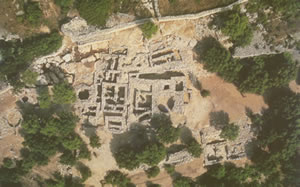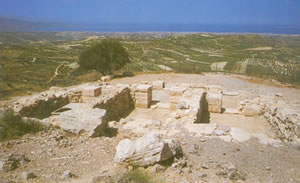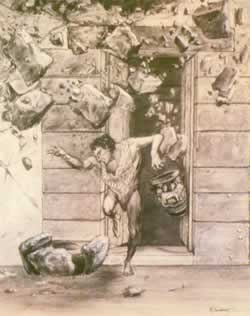 Phourni is to the right as
you enter the town and just before the school. To reach it requires a walk (10-15 minutes) up a steep trail. A burial ground was found here with tombs dating from 2500 B.C.
(before the main palaces were built). The cemetery was in use from 2500-1250 BC and is the most extensive Minoan cemetery that has been found. There are tholos tombs
(beehive-live round structures) which involved multiple burials in large clay jars (pithoi) and in sarcophagi (stone coffins, usually with inscriptions). Tholos A was used as
hiding places during the second World War. The floor was covered with debris, and below it, in a side chamber behind a fake wall, was found a royal lady or priestess from the
fourteenth century BC. She was dressed in a garment trimmed with gold and around her were offerings of jewelry and the ritual a bull and horse which had been sacrificed. In
Tholos C were found marble Cycladic figurines and jewelry in the style of items found at Troy by Schliemann, and which were dated to 2500 BC.
Phourni is to the right as
you enter the town and just before the school. To reach it requires a walk (10-15 minutes) up a steep trail. A burial ground was found here with tombs dating from 2500 B.C.
(before the main palaces were built). The cemetery was in use from 2500-1250 BC and is the most extensive Minoan cemetery that has been found. There are tholos tombs
(beehive-live round structures) which involved multiple burials in large clay jars (pithoi) and in sarcophagi (stone coffins, usually with inscriptions). Tholos A was used as
hiding places during the second World War. The floor was covered with debris, and below it, in a side chamber behind a fake wall, was found a royal lady or priestess from the
fourteenth century BC. She was dressed in a garment trimmed with gold and around her were offerings of jewelry and the ritual a bull and horse which had been sacrificed. In
Tholos C were found marble Cycladic figurines and jewelry in the style of items found at Troy by Schliemann, and which were dated to 2500 BC.
Shaft graves constructed in Mycenaean style were also found here-- seven of them in a circle. The pit, or 'vothros' where sacrifices were made to the dead, still reeked after more than three thousand years from the accumulated stench of the offerings that had been made there. There are also simpler graves as well in this cemetery. (8:30am-3pm daily
 Anemospilia, 2 km northwest of Archanes can be visited. Excavations were carried out there in the 1980s and evidence of what appeared to have been a
human sacrifice aroused much controversy, as it contradicted the conventional view of Minoan civilization as humane and peaceful. It is one of three sites that have provided
such evidence: along with Fournou Korifi in southern Crete (a peak sanctuary complex), and Knossos (in a building known as the "North House"). At Anemospilia
(right) were found ruins of a supposed temple destroyed by earthquake during the Middle Minoan Period. The skeleton of a man was found on a raised platform and in a
position that led some to believe that he had been tied up for sacrifice, and that the platform was a sacrificial altar.
Anemospilia, 2 km northwest of Archanes can be visited. Excavations were carried out there in the 1980s and evidence of what appeared to have been a
human sacrifice aroused much controversy, as it contradicted the conventional view of Minoan civilization as humane and peaceful. It is one of three sites that have provided
such evidence: along with Fournou Korifi in southern Crete (a peak sanctuary complex), and Knossos (in a building known as the "North House"). At Anemospilia
(right) were found ruins of a supposed temple destroyed by earthquake during the Middle Minoan Period. The skeleton of a man was found on a raised platform and in a
position that led some to believe that he had been tied up for sacrifice, and that the platform was a sacrificial altar.
 What appeared to them to
be a bronze dagger found among his bones and discolored bones on one side of his body reinforced this argument for them. Three other skeletons were found nearby, some with
broken bones, appeared to have been killed in a sudden earthquake. Others (including Nanno Marinatos) disagreed with this version and maintained that all died in an
earthquake; that the building was not a temple, and that the knife was really a spearhead and could have fallen from elsewhere during the earthquake. These arguments are more
convincing than those advanced against the human sacrifice theory in regard to the skeletons of children that appeared to have been butchered that were found at Knossos during
the Late Minoan period.
What appeared to them to
be a bronze dagger found among his bones and discolored bones on one side of his body reinforced this argument for them. Three other skeletons were found nearby, some with
broken bones, appeared to have been killed in a sudden earthquake. Others (including Nanno Marinatos) disagreed with this version and maintained that all died in an
earthquake; that the building was not a temple, and that the knife was really a spearhead and could have fallen from elsewhere during the earthquake. These arguments are more
convincing than those advanced against the human sacrifice theory in regard to the skeletons of children that appeared to have been butchered that were found at Knossos during
the Late Minoan period.
On the road south from Vathypetro are the church of Aghios Vasilios amid the convent Moni Spiliotissa (monastery of the cave) , the latter built into a cave hidden by plane trees. There is a spring in the cave which the Ottomans piped to Heraklion, and which was said to have therapeutic properties. The church has thirteenth century BC frescoes.
Heraklion Prefecture Crete Continued1 | 2 | 3 | 4 | 5 | 6 | 7 | 8 | 9 | 10 | 11 | 12 | 13 | 14 | 15 | 16 | 17 | 18